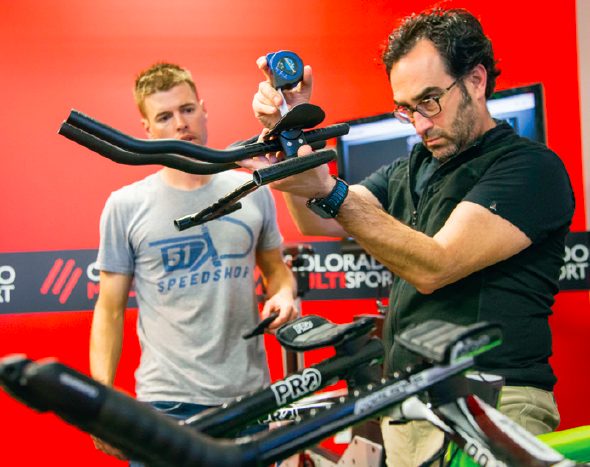Bike fit: Dial in your position with tips from an expert

— By Dave Ripley
Let’s make one thing completely clear: a poorly set up triathlon bike is miserable. Fit is where it all starts when it comes to performance on a bike. Because of my passion about bike fit, a few years ago I left a longterm position with Zipp to partner with Mat Steinmetz of 51 Speed Shop and opened a studio in Indianapolis. We specialize in figuring out how to maximize the value of your investment. Believe it or not, you don’t always have to spend thousands of dollars to get the most out of the bike leg in your next triathlon. My job is to get you the most performance for the amount you have to spend.
While there are lots of bike fitters out there who are using a variety of different systems, those systems (BikeFit, Retul, Guru) are only as good as the person who is putting the numbers into the program. I recently had a guy come in to the studio who was 6’5″ tall. We actually fit him onto a medium-sized Giant Trinity. Any bike shop would have naturally put him on the biggest frame they had in the store. You have to analyze how people sit on a bike when it comes to dialing in the right position and frame size. Biomechanically we’re all basically the same, but proportionally we’re all different.
Here are some of the key factors you should look at to dial in your bike position and get the most out of yourself – and your bike – this season.
Priorities
When it comes to your setup the priorities are: comfort, power and aerodynamics. In that order, no matter what level of triathlete you are.
Sitting pretty
The saddle is the key to everything, regardless of what type of riding you’re going to be doing. A saddle has to do three things: support you, put you in a position that provides optimal leverage over the cranks and allows anterior pelvic rotation that allows you to relax your lower back. Once you’re in that position you’ll be able to control the front end of the bike rather than prop yourself up on it. There’s a reason that anatomic saddles with channel relief (cutouts) are the most used saddles in Kona – long-distance triathletes will gravitate towards those saddles in order to get the most comfort and performance.
Position
Once I have your saddle and seat position dialed in, I spend lots of time on the position of your aero pads. You need to be comfortable in the aero position and stay down for as much of the race as possible.
Speed time
Once you are moving at more than 16 mph, aerodynamics is the only thing that really matters. Once you’ve dialed in your position, the next most important factor on your bike is your wheels. Really good wheel products work. Copy-cat wheel products don’t work. For the average consumer, it’s hard to figure out what works and what doesn’t because of all the marketing their subject to.
Hydration
All of the peripheral parts of the bike come next. Clean up the front end of your bike by hiding all the cables and finding an aerodynamic hydration system. When it comes to an on-the-bars water bottle, horizontal options where the bottle lays flat between your arms is the best. Those systems are the most functional and provide the best performance. You want to minimize the bike’s profile as much as you can, but never compromise on your needs. You might gain four seconds an hour by getting rid of a water bottle cage, but if you bonk because you didn’t have enough liquid you’ll lose a lot more time than that.
Aero everything
Don’t just stop at your bike. There are lots of little things that you can utilize that will go a long way to improving your performance. You need to wear a helmet, so why not make your next helmet purchase an aero one? That said, make sure you’re getting the right aero helmet, one that corresponds to your bike fit.
Resistance
Another “must have” that is easy to change on race day are your tires and tubes. Good performing tires and tubes have a huge advantage when it comes to rolling resistance – upwards of 15 to 20 watts. Latex tubes roll much faster than butyl tubes, so why not throw some of those on for your race? Butyl tubes hold air much better, so you’ll want them for your day to day training rides, but making the switch for race day can make a huge difference. So take the extra time every race weekend and have yourself some training and racing tubes and tires.
Tires
Recent research has also shown that good clincher tires and rims can perform better than tubulars.
Game changers
Finally, don’t believe that any one piece of equipment is the “fastest.” Everything is subject to the other parts of the system. Maximize your aero potential based on what you have and what you can afford. Ultimately that will make the biggest difference.
After many years in aerospace with Rolls Royce, Dave Ripley now runs the 51 Speedshop in Indianopolis, Ind.

